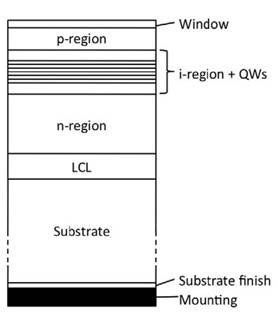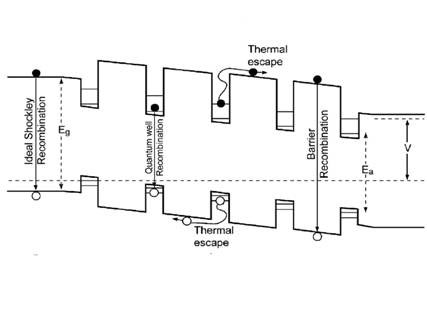Trapping solar energy in quantum wells increases gain and efficiency of solar cells. Brett Cherry
A ‘quantum well’ is a potential well that confines particles to two dimensions that are otherwise free to move in three dimensions. Both electrons and holes can be confined in semiconductor quantum wells. The effect is to increase the gain and efficiency of the solid state device such as lasers in CD or DVD players, infrared imaging, and more recently, solar cells.
A quantum well is basically a semiconductor with a small energy gap (or band gap) sandwiched between two thicker layers of semiconductor(s) with a large energy gap, such as gallium arsenide (GaAs). (see [1] Solar Power For The Masses for a description of a solar cell). Quantum wells in solar cells confine electrons and holes that normally move in three dimensions to two dimensions. The number of electrons and holes confined is determined by the thickness of the semiconductor used, usually ranging from 1-10 nanometres. Confining electrons within quantum wells allows them to be easily converted to useful forms of energy, and it is the thinness of the semiconductor material that allows this to happen.
Quantum well solar cells are built with multiple nanoscale semiconductors layered on top of one another with a lateral conduction layer between the substrate and n region to allow contact between each device (Fig. 1). In solar cells, the quantum wells making up part of the thin i layer in a p-i-n junction confines the electrons to two dimensions. This means electrons and holes are quantized, having discrete levels of energy. Within the i layer of the junction, the potential energy of an electron is less than the outside layer so the flow of charge is confined to certain well-defined regions that can be exploited in solar photovoltaics. Quantum wells are grown by molecular beam epitaxy, where atoms of the materials are delivered to crystals using a molecular beam or through chemical vapour deposition, using a flowing gas.

Figure 1. Quantum well solar cell. QW – Quantum Well. LCL – lateral conduction layer [2]
Professor Keith Barnham of Imperial College London, who invented the quantum well solar cell in 1989, was originally funded by the Greenpeace Environmental Trust. Barnham is now Chief Scientific Officer and Director of QuantaSol, an independent UK-based solar PV company that will bring quantum well solar cells to the solar industry. The solar cells developed by Barnham operate at high current. The i region consists of alternating layers of indium gallium arsenide (InGaAs) and gallium arsenide phosphide (GaAsp), while the p and n layers of the solar cell are made from gallium arsenide GaAs. A “strain balance” technique is used to grow the different layers, which matches the lattice structures of the different semiconducter materials, preventing defects [3]. This method allows more than 65 wells to be grown on top of one another without dislocation [2].

Figure 2. Strain-balanced quantum well solar cell [3] [2]
The band gap of Barnham’s single junction quantum well solar cell is also better matched to the solar spectrum at 1.33eV than a 1.42eV gallium arsenide (GaAs) solar cell [4] (see [5] Very High Efficiency Solar Cells, SiS 43). Quantum well solar cells avoid efficiency losses that plague most solar cells because the quantum wells have a lower band gap than the rest of the cell as illustrated in Fig. 2 where the band gap (V) is higher than the absorption threshold (Ea) of the quantum wells; this allows electrons to enter the wells after being hit by incoming lower-energy photons, contributing extra current [6]. It also reduces dark current, an electric current generated from the potential difference between the terminals of the PV cell that flows in the opposite direction of the photocurrent, decreasing net efficiency. A 1cm x 1cm multi-junction quantum well solar cell can reach a high current of 7 Amps at 500x solar concentration [4]. “We can never get rid of all the traps and defects and so on, but we can fill’em up by operating at a higher current,” said Barnham.
Like conventional solar PV for micro-generation, the cost per kWh for industrial scale solar PV depends largely on various environmental factors such as the amount of solar insolation (the solar power density incident on a surface of stated area and orientation, usually expressed as Watts per square metre) and solar cell efficiency. Assuming a full life cycle of 25 years for the concentrating photovoltaic (CPV) power plant, the best estimate today would be near $0.20 US per kWh. QuantaSol expects to be competitive with current CPV rates if not better. In comparison, current global average cost per kWh for a 2 kWh residential system is $0.37 US in a “sunny climate” and $0.81 US per kWh in a “cloudy climate” [7]. This average does not include government rebates, such as feed-in tariffs in countries such as Germany, so prices for individual countries will vary. Projected costs for solar electricity are expected to continue to drop in the future as manufacturing costs go down. China, for example, is planning to reduce the cost of solar power generation to $0.146 US per kWh by 2012 [8]. With a combination of widespread solar systems for micro-generation and industrial PV power plants, these lower energy prices could be achieved at a fraction of the green house gases emitted today. Another obstacle to overcome in making solar electricity more affordable for industrial and small scale uses is storing solar energy [9] (see Harvesting Energy from Sunlight with Artificial Photosynthesi, SiS 43) when it is no longer available at night. In the future, in order for solar electricity to be more sustainable and reliable, new storage technologies must be developed, especially the use of solar light to break down water into hydrogen and oxygen for use as a fuel, as research in artificial photosynthesis has shown [10] [11] (see Making Fuel from Water and Splitting Water with Ease, SiS 43).
As losses are due to recombination, quantum wells create a more efficient cell by allowing researchers to adjust the band gap in order to minimise recombination. “If you adjust the band gap you can adjust how much [energy] each cell produces,” said Barnham.
Once recombination is controlled in order to get the most current possible, the next step is to find ways of recovering losses of light absorbed by the cells through photon recycling [3], as the bulk regions of the solar cell are transparent to radiation from the quantum wells. Photon recycling can prevent incoming high-energy photons from being wasted as heat.
To recycle photons, a reflector is used to reflect light back to the cell so it can be reabsorbed to increase current. Reflectors used include the Distributed Bragg Reflector (DBR, also used in fibre optics) and the Luminescent Solar Concentrator (LSC) doped with quantum dots or nano-rods to increase light absorption and remit it to the solar cells.
Barnham and his team discovered that internal reflection within the cell itself is often the best form of photon recycling. In order to achieve optimal reflection within the solar cell in some cases an air gap is all that is needed [3]. Reflecting back photon losses onto the solar cell results in an increase of 1.5 percent efficiency for single junction solar cells and potentially more for multi-junction solar cells.
Barnham and his team currently hold the record for highest efficiency of a nano-structured solar cell at 30.6 percent, obtained from a tandem-junction quantum well solar cell at a concentration of 54 suns. One sun is about the amount of light that makes it to the Earth on a sunny day. Recently, their gallium arsenide phosphide and indium gallium arsenide (GaAsp/InGaAs) single junction solar cell has also broken the world record (28.2 percent) for single junction cells at 28.3 percent with a concentration of 500+ suns.
The life-cycle assessment (LCA) [12] (see Which Renewables? SiS 39) of solar PV cells provides an indicator for how well solar cells perform in terms of energy payback and emissions of greenhouse gases from ‘cradle to grave’. According to recent studies on concentrating solar PV life cycles, the energy payback time (EPBT) is currently 0.7-1.3 years for one concentrating system examined, SolFocus [13]. This is slightly better than rooftop silicon PV solar cells that have an EPBT of 1.1-2.7 years. Based on recent analyses, the amount of greenhouse gases emitted by concentrating solar PV is not yet known, but for silicon solar cells it is 30-55 g/kWh and CdTe (cadmium telluride or thin film PV) is 21-25 g/kWh.
QuantaSol plans to make their quantum well solar cells commercially available to solar concentrator manufacturers early next year. Their goal is to develop quantum well solar cells specifically tailored to the spectral conditions in relation to the placement of concentrators and to optimise both for peak efficiency for utility-based solar PV. In time, as the costs come down, quantum well solar cells with concentrators could be used for micro-generation and for other conventional solar PV applications. QuantaSol is currently researching how its quantum well solar cells will perform under different environmental conditions to get the best possible cost per kWh.
Article first published 20/07/09
Comments are now closed for this article
There are 5 comments on this article.
Tom Blakeslee Comment left 21st July 2009 01:01:38
Such high solar concentration becomes very inefficient if clouds or haze are present. Here's a 42.8% cell with much less magnification:
http://www.udel.edu/PR/UDaily/2008/jul/solar072307.html
Brett Comment left 28th July 2009 20:08:30
Diffuse sun light due to cloud cover is certainly an important issue, this is why tracking is necessary. It is preferable to have direct sun in order to achieve high concentrations of sun light, but it depends on what type of concentrator you are using, along with environmental conditions (such as solar insolation) in order to accurately judge efficiency. The fact that single-junction solar cells are capable of reaching such high efficiencies is most important.
Research referred to at University of Delaware on very high effciency multi-junction solar cells is explained in this article: http://www.i-sis.org.uk/veryHighEfficiencySolarCells.php
R.G.McCraney Comment left 22nd January 2010 03:03:05
28 Jan 2010
The end-user sustainability of concentrated solar PV systems MUST be a target for R&D.
High efficiency PASSIVE PV systems that survive storms and earthquakes are DISRUPTIVE technology for concentrated PV systems.
M. Jabbarzadeh Comment left 29th August 2010 17:05:33
I think 0.1% increase in efficiency is not too much (28.2% to 28.3%) considering complexity of QWSC
mr attah Comment left 9th December 2010 01:01:22
i want to commend your work,keep it up.can u please help me with articles on the problems of quantum wells in electronic materials